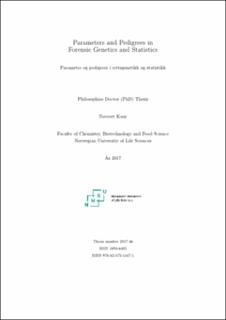| dc.contributor.advisor | Egeland, Thore | |
| dc.contributor.advisor | Dørum, Guro | |
| dc.contributor.author | Kaur, Navreet | |
| dc.date.accessioned | 2020-11-24T15:07:42Z | |
| dc.date.available | 2020-11-24T15:07:42Z | |
| dc.date.issued | 2017 | |
| dc.identifier.isbn | 978-82-575-1447-1 | |
| dc.identifier.issn | 1894-6402 | |
| dc.identifier.uri | https://hdl.handle.net/11250/2689409 | |
| dc.description.abstract | With the rapidly evolving DNA technology today, there is a constant need of more robust statistical methods for analyzing the data. The sequencing techniques are improving, making more genetic markers available, and we are able to analyze even smaller samples of degraded DNA gathered from crime scenes. Many of the traditional and commonly used statistical methods need therefore to be updated.
When a crime is committed and a suspect is found, two competing hypotheses are generally presented. The custom in forensic statistics has for long been to present competing hypotheses verbally. The prosecutor may suggest the hypothesis Hp: “the suspect contributed to the stain”, whereas the defense attorney may suggest the hypothesis Hd: “an unrelated person contributed to the stain”. However, giving a more statistical presentation of the problem can be beneficial as the statistical tools used to test the hypotheses then can be more sophisticated. In particular, by giving the problem a parametric form we are able to present the problem in a more conventional statistical framework. Using parametric models makes it possible to apply already well-known mathematical and statistical models for evaluating the hypotheses, and we are able to get an alternative understanding of the problem. For instance, when making kinship inference, a parametric formulation of the problem facilitates more generalized alternative hypotheses, and we no longer need to test a specific relation versus unrelatedness: the alternative can be any other relation.
This thesis aims at describing different parametric approaches for forensic applications. The thesis considers both pure kinship cases and forensic crime cases, and cases where these two subfields of forensics overlap. We deal with complex DNA mixture problems and present methods for identifying the contributors to the mixture. We also study kinship cases where mixtures appear, and suggest methods for determining the relation between the mixture contributors. Methods for relationship inference based on statistical estimation of the parameters is also presented, and we make use of statistical theory that deserve attention in a forensic framework. | en_US |
| dc.description.abstract | DNA teknologien utvikler seg i en stor fart, og med dette tempoet trengs det stadig nye og mer robuste statistiske metoder for å analysere data. Sekvenseringsteknikkene bedres også og fører til at vi i dag har langt flere genetiske markører tilgjengelig. Med teknologien tilgjengelig i dag kan man analysere selv mindre mengder med degradert DNA i kriminalsaker. Vi trenger derfor nye og bedre tilpassede statistiske metoder.
Etter at en kriminell handling har funnet sted presenteres det ofte to hypoteser. I rettsgenetisk statistikk har det i lang tid vært vanlig å presentere slike hypoteser verbalt. Aktor kan for eksempel foreslå hypotesen Hp: “mistenkte bidro til DNA-sporet”, mens forsvaret har følgende hypotese Hd: “en urelatert person bidro til DNA-sporet”. En tradisjonell matematisk statistisk formulering av problemet kan være fordelaktig. Mer spesifikt vil en parametrisk tilnærming åpne for at vi kan bruke velkjente matematiske og statistiske metoder for å teste hypotesene. Dette vil også gi oss en alternativ forståelse av problemet. I slektskapsanalyser vil for eksempel en parametrisk fremstilling gi oss muligheten til å gi mer generelle alternative hypoteser i den forstand at vi ikke lenger trenger å teste en spesifikk relasjon versus ubeslektet: den alternative hypotesen kan være generell.
Denne avhandlingen har som mål å beskrive slike parametriske metoder innen rettsgenetikk og statistikk. Avhandlingen tar for seg både rene slektskapssaker og kriminalsaker, samt saker dere disse to feltene innen rettsgenetikk overlapper. Vi tar opp problemer med komplekse DNA blandinger og presenterer metoder for å identifisere bidragsyterne til blandingen. Vi ser også nærmere på slektskapssaker der DNA blandinger inngår, og studerer metoder for å bestemme familierelasjonen mellom bidragsyterne. Metoder for slektskapsidentifisering basert på statistisk estimering av parametere presenteres også, og vi tar i bruk statistisk teori som fortjener oppmerksomhet i en rettsgenetisk sammenheng. | en_US |
| dc.language.iso | eng | en_US |
| dc.publisher | Norwegian University of Life Sciences, Ås | en_US |
| dc.relation.ispartofseries | PhD Thesis;2017:46 | |
| dc.rights | Attribution-NonCommercial-NoDerivatives 4.0 Internasjonal | * |
| dc.rights.uri | http://creativecommons.org/licenses/by-nc-nd/4.0/deed.no | * |
| dc.subject | Forensics | en_US |
| dc.subject | statistics | en_US |
| dc.subject | parameters | en_US |
| dc.subject | pedigrees | en_US |
| dc.subject | DNA mixtures | en_US |
| dc.subject | kinship analysis | en_US |
| dc.title | Parameters and pedigrees in forensic genetics and statistics | en_US |
| dc.title.alternative | Parametre og pedigreer i rettsgenetikk og statistikk | en_US |
| dc.type | Doctoral thesis | en_US |

